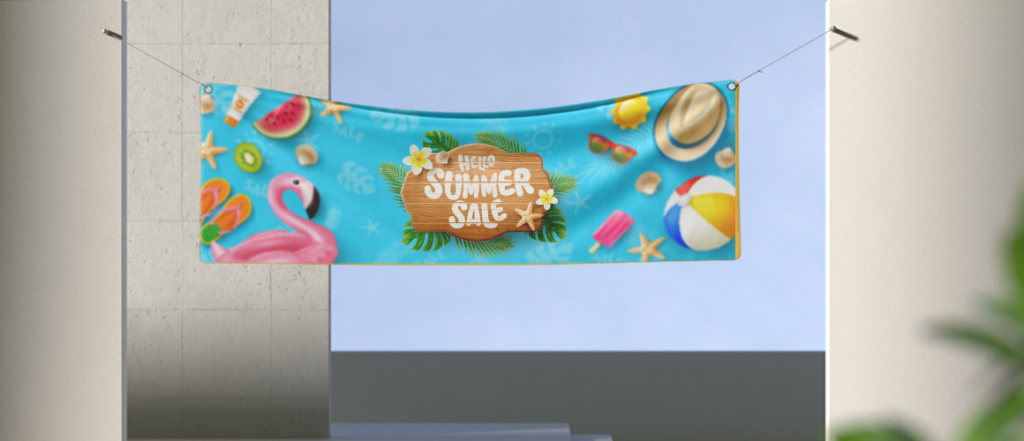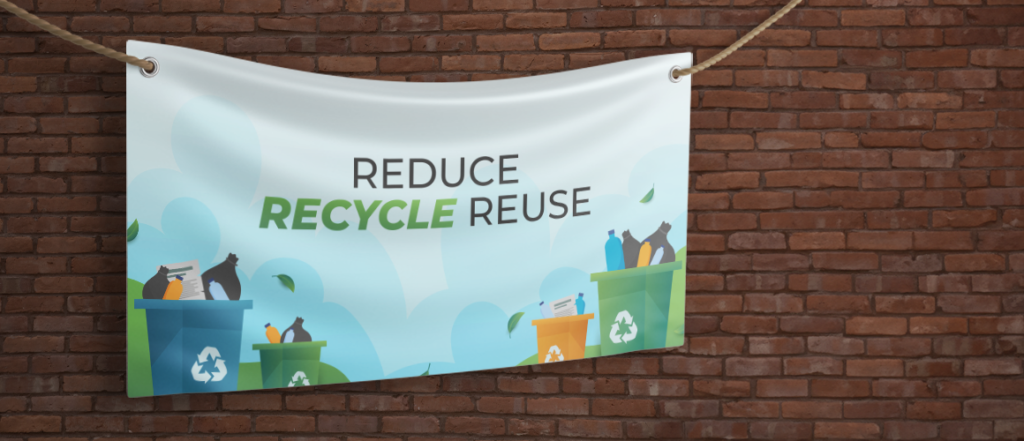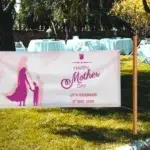When it comes to banner printing, one of the key decisions businesses face is choosing the right material. Some of the most popular options include vinyl, PVC-free flex, and polyester fabric banners. Each material offers distinct advantages and drawbacks, depending on the specific needs of your advertising campaign or display project. Among these, the most common confusion arises between vinyl and PVC-free flex banners and understanding what actually sets them apart can be challenging.
In this blog, we will dive into the key differences between vinyl vs PVC-free flex banners, analyzing factors like durability, environmental impact, printing quality, and more. We’ll also explore which material might be better suited for various uses, giving you a clearer picture of the ideal material for your business.
To start with, here’s a quick comparison of both types of banners:
| Feature | Vinyl Banners | PVC-Free Flex Banners |
| Material | Made from polyvinyl chloride (PVC) | Made from eco-friendly, PVC-free materials |
| Environmental Impact | Non-biodegradable | Recyclable and biodegradable, eco-friendly |
| Durability | Highly durable, withstands harsh weather | Durable, but less suited for extreme weather |
| Water Resistance | Excellent water resistance, ideal for rainy climates | Moderate water resistance, may need treatment |
| Weight | Generally Heavier | Lightweight, easier to transport and install |
| Printing Quality | Smooth surface, vibrant colors, sharp details | High-quality prints with sharp details and vibrant colors |
| Surface Finish | Reflective, can cause glare in bright lighting | Non-reflective matte finish, ideal for photography |
| Cost | More budget-friendly for bulk orders | Higher upfront cost compared to vinyl |
| Breathability | Less breathable, more prone to wind damage. But incorporating wind flaps can solve the purpose | Breathable, reduces tearing in windy environments |
| Customization | Can be customized in size, personalized with logo, text, and images | Can be customized in size, personalized with logo, text, and images |
| Best For | Long-term outdoor use, areas with extreme weather | Indoor events, eco-conscious businesses, mild outdoor use |
Let’s explore in detail…
Understanding Vinyl Banners

Vinyl banners have long been a go-to option for many businesses and event planners. They are made from a synthetic plastic material known as polyvinyl chloride (PVC). Vinyl polyester banners material offers high durability and is water-resistant, making it ideal for both indoor and outdoor use.
Benefits of Vinyl Banners
- Durability: Vinyl is highly resistant to weather elements like rain, wind, and sunlight, ensuring that the banner maintains its integrity and vibrancy even in harsh outdoor conditions.
- Cost-effective When considering bulk orders or larger banners, vinyl tends to be more budget-friendly, which makes it a popular choice for businesses needing affordable but effective advertising materials.
- Printing Quality: Vinyl works exceptionally well with modern printing technology, ensuring that images and text are sharp, clear, and vibrant. The material’s surface is smooth, allowing for excellent ink adhesion, which results in high-quality prints.
- Versatility: Custom Vinyl banners can be tailored and designed to fit various applications, from small indoor banners to large outdoor billboards.
- Waterproof: Since vinyl is naturally resistant to water, vinyl banners are great for locations where moisture or exposure to rain might be a concern.
Drawbacks of Vinyl Banners
- Environmental Impact: Vinyl contains PVC, a material that can be harmful to the environment during production and disposal. It is non-biodegradable and can release harmful chemicals if incinerated improperly.
- Heavier Material: Vinyl is a thicker, heavier material compared to alternatives like polyester, which can make it cumbersome for large installations or mobile advertising needs.
- Less Eco-friendly: For businesses looking to adopt a greener approach to their branding and marketing materials, vinyl may not align with sustainability goals.
Understanding PVC-free Flex Banners

In response to growing environmental concerns, many businesses are now exploring PVC-free flex banners. Although this can be a never-ending debate, the dilemma of vinyl vs polyester banners for printing carries on, regardless. These banners offer an eco-friendlier alternative without compromising on quality or durability.
Benefits of PVC-Free Banners
- Eco-Friendliness: PVC-free banners are made from environmentally friendly materials, often recyclable polyester alternatives. These banners have a much lower carbon footprint during production compared to traditional vinyl banners. Their biodegradability makes them a sustainable option for businesses looking to reduce their environmental impact.
- Lightweight: PVC-free banners are much lighter than vinyl banners, which makes them easier to transport, install, and handle. This feature is especially useful for indoor events or exhibitions where banners may need to be moved frequently.
- High-Quality Prints: Like vinyl, PVC-free banners offer excellent printing quality, delivering vibrant colors and sharp details. The smooth surface of these materials allows for high-resolution images that hold up well over time without significant fading.
- Non-Reflective Surface: Unlike traditional vinyl, PVC-free banners have a non-reflective matte finish, making them ideal for use in settings with bright lighting, such as photography backdrops, media events, and stage settings, where reflective surfaces could interfere with cameras and lighting.
- Durability and Breathability: PVC-free banners are designed to withstand various conditions. They offer greater breathability than vinyl, allowing some air to pass through, which helps prevent tearing in windy environments. This feature makes them a great option for outdoor displays where weather can be a concern.
Drawbacks of PVC-Free Banners
- Cost: One of the main drawbacks of PVC-free banners is their higher upfront cost compared to vinyl. For businesses with budget constraints, this may be a deciding factor when choosing between materials.
- Durability in Harsh Weather: While PVC-free banners are durable, they may not stand up as well as vinyl banners in extreme weather conditions, particularly in heavy rain or strong winds. For long-term outdoor use in harsh environments, vinyl banners might be the better option.
- Water Resistance: Though PVC-free banners can be treated for water resistance, they generally do not offer the same level of waterproofing as vinyl banners. In particularly rainy or humid climates, traditional vinyl may provide better protection.
PVC-Free Banners vs. Vinyl Banners for Printing
When comparing PVC-free banners to vinyl banners for printing, both materials can produce high-quality results. However, the key differences lie in their sustainability, aesthetics, and weather resistance:
- Sustainability: PVC-free banners are the clear winner when it comes to eco-friendliness. They are made from materials that are recyclable and biodegradable, making them a better option for environmentally conscious businesses.
- Aesthetics: PVC-free banners typically have a matte finish, giving them a sophisticated, non-reflective look. Vinyl banners, by contrast, tend to have a shinier surface that can reflect light, which may not be ideal for certain uses like photography or stage settings.
- Longevity: While both types of banners hold ink well, vinyl banners tend to have a longer lifespan, particularly in outdoor settings. Their resistance to harsh weather conditions and their water resistance make them better suited for long-term outdoor use.
In the debate of vinyl vs. PVC-free flex banners, the choice ultimately boils down to what best fits your needs. Both materials offer strong benefits, whether you prioritize durability, eco-friendliness, or aesthetic qualities. If you need a banner that will withstand outdoor elements and you have a larger budget, vinyl might be the better choice. However, if sustainability is important to you, or you need something lightweight and non-reflective for indoor use, PVC free flex banners are an excellent alternative. Apart from this, you can also consider fabric banners for indoor and outdoor promotional purposes.
Whether you choose fabric banners or custom vinyl banners, understanding the strengths and limitations of each material will help you make an informed decision that enhances your advertising efforts while staying true to your business values.
Written by BannerBuzz Editorial Team.


























 Posted in
Posted in 












